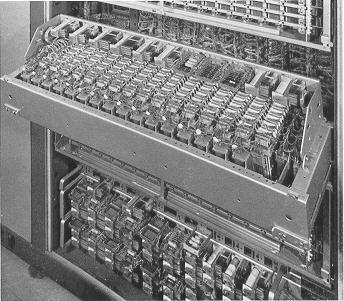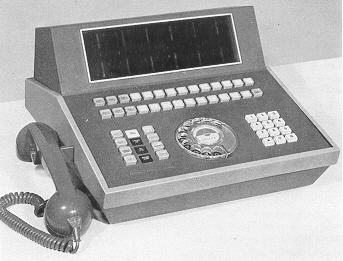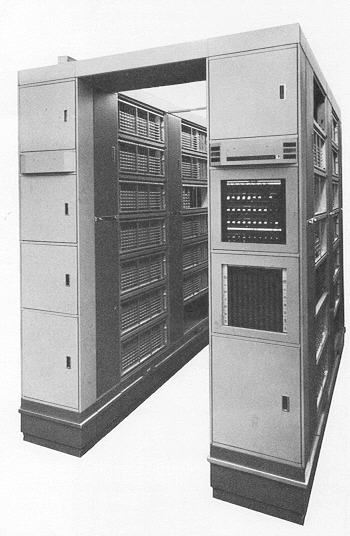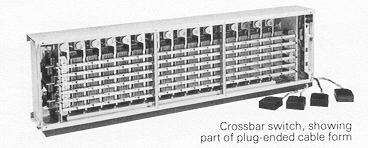Crossbar
PB480 PABX
Typical PB480 exchange shown The PB480 is an extensible common-control
crossbar exchange that offers the latest facilities combined with proven switching
techniques and straight forward equipment practice. The PB480 is an extensible common-control
crossbar exchange that offers the latest facilities combined with proven switching
techniques and straight forward equipment practice.
The basic exchange caters for 120 internal extensions, 20 exchange lines and 1 desktop
switchboard and is readily extensible up to 480 extensions, 60 exchange lines and 3
operator switchboards. Exchange lines can be replaced on a one-for-one basis by
private-wire circuits.
Up to 10 individual private wire routes and five special services (such as dictation
recording) can be accommodated.
The PABX employs simple 3-stage switching based on the well tried Plessey 5005 crossbar
switch and has a high traffic-handling capability of 0.17 erlang per extension (or 17 per
cent occupancy).
Design Highlights
- FULL pressbutton operation, dependent upon public-exchange signalling arrangements.
- Modular construction
- 5005 crossbar switching principles
- High-quality speech
- Flexible numbering
- Attractive equipment units
- Quiet operation
- Low maintenance
- Simplified installation
- Extension Classifications
- Extensions can be arranged in any of three service classifications by appropriate
wiring straps:
- Unrestricted allowing full traffic facilities.
- Trunk barred allowing full traffic facilities with the exception of trunk calls
(special trunk discriminating equipment is provided).
- Barred direct access allowing external calls to be originated and received via the PABX
switchboard only.
- Fully barred allowing internal calls only.
Extension Facilities
Extension Calling
Extension-to-extension calls are unrestricted and keyed directly by the calling extension.
Connection is released when either party clears.
Discriminating Ringing
Two distinctive types of ringing enable extensions to differentiate between internal and
external calls.
Hold for Enquiry
Pressing the enquiry key once enables an extension to hold an established external call
while making an enquiry call to another extension.
Add on Conference
A second operation of the enquiry key by the originating extension allows entry of the
external caller to the enquiry connection, thus permitting 3-way conference. A third
operation of the enquiry key returns the originating extension to the external caller.
Automatic Transfer
When an. enquiry call has been established, the originating extension can offer the
external call to the called extension and transfer it automatically by replacing the
handset.
If transfer fails owing to mis-operation by the extension originating it, the external
call is automatically transferred to the PABX operator's switchboard.
Operator Recall
An extension engaged on an external call can, on successive operation of the enquiry and
'0' keys, signal the PABX operator for assistance.
Automatic Through Clearing
An external call is cleared immediately the extension user replaces the handset to
terminate the call.
Operator Facilities
Pressbutton Signalling (PBS) and Selective Answering PBS for all extensions, inter-PBX
lines and exchange lines.
Route Busy & Group Display
A 'busy' lamp is provided for each exchange line and inter-PBX line, illuminating the
appropriate number on the glass indicator panel.
Also provided is an indication of the 10-line groups controlled by the switchboard(s):
Indication of Assistance Calls
Awaiting Attention
Lamp & Tone Supervision of All Calls Connected by the Operator(s)
Delay Recall
if any recall is extended by the PABX operator and not answered within 30-60 seconds, the
call is automatically reverted to the PABX operator.
Ring when Free
This facility (also called 'camp on busy') is automatically applied on calls from the PABX
operator to engaged extensions.
Trunk Offering
The operator(s) may intrude into any established connection, with warning tone.
Call Splitting
The operator(s) can 'speak to extension' or 'speak to exchange' without overhearing by the
other caller.
Series Calls
An incoming caller wishing to speak to several extensions in succession can receive
special routing and supervision by the operator.
Prompt, Deferred and Charger-Fail Alarms
Exchange Facilities
Night Service
Incoming exchange calls during the night service period can be either routed to selected
extensions or signalled by special bells
and answered by any extension by keying '8'.
PBX Group Hunting
Any 20 extensions in each 120-line unit can be formed into four hunting groups, each of
five lines. Any call made to a group number will ring the first free telephone in the
selected group.
Line Lockout
This occurs if a call does not proceed within the permitted time following handset
pick-up, causing the line to be 'parked'. Lockout also takes place if the line is faulty
or if the caller fails to clear at the end of a call.
Private-wire Connections
Calls can be made to or from other private exchanges automatically, or via the PABX
operator.
Optional Facilities
- Loop/disconnect dialling for all extensions.
- Direct dialling-in (DDI).
- Extension-busy display panel(s).
- Transit switching of private-wire calls in conjunction with a PT100 tandem exchange.
- STD metering of extensions or exchange lines.
- Emergency reporting.
- Dictation recording.
- Data transmission by modem and Teleprinter to time-sharing computers.
- Staff location (Paging access)
- Absent-service diversion to nominated extensions.
- Loudspeaking direct-access master stations for senior executives.
Trunking
The PB480 uses the link principle of trunking, with register control of routing. Selection
of a free speech path is obtained by the well-tried self-steering principle as used in the
5005A main exchange. With this arrangement connection is made between two terminal points
via a number of switching stages; simultaneous marking signals are applied to the two
terminal points and a circuit via one of the available paths is completed without the aid
of any external control circuits.
Equipment Cabinets

The automatic equipment is housed in double-sided floor, fixing cabinets
(shown right)..
Sheet and angle-section steel is used for the structural framework which has an attractive
dual smooth/textured finish in hemp beige and loam brown. Individual front and rear shelf
covers of clear flame-retardant plastic afford convenient external viewing, good
mechanical protection and a dust-free interior.
The covers, retained by metal hooks fixed to the cabinet sides, are reinforced along the
hanging edge and firmly held against the cabinet frame by magnetic tape along the
remaining edges. During inspection of the equipment a cover can be simply lifted
from its mounting and 'parked' on the hooks retaining an adjacent cover. Three types of
shelf module are used, equipped with (a) a crossbar switch with up to 16 bridges, (b) a 10
or 5 + 5 bridge crossbar switch and relays and (c) relays alone. Each shelf has its
components clearly designated and can be swung forwards and downwards to a self-locking
position for inspection and testing purposes.
Jack-in relay sets of 10, 20, 30 or 40 relay capacity, as required, are accommodated in
the cabinets. Fuse panels and test jacks for battery and common services are mounted
at the top of the cabinets.
The cabinet wiring terminates on tag blocks outside the main dust protected shelving, i.e.
in the end suite of inter-rack frames, to which access is obtained via lift-off panels.
The tag block wiring is by solderless gun-wrapping, and p. v. c. insulated wire is used
throughout.
External cabling enters via the top of the cabinets.
The number of cabinets required for particular line capacities is shown in the table
below. Two types of ringing and tone
equipment are available, together conforming to most standards adopted throughout
the world. In each case the ringing and tone frequencies and the ringing current are
generated by transistor type oscillators powered from 50V exchange supply.
PABX Operator's Switchboard

The operator's switchboard (shown right) occupies small space and matches
the PABX equipment cabinets in colour scheme and finish.
The switchboards comprise of lamps, simple press-to-release and non-locking actions,
and pressbuttons in contrasting colour. In addition a Keyset is provided for use on both
internal and external calls. The dial is for emergency use only.
Up to three operator switchboards are provided to deal with the maximum of 60 public exchange lines.
Normally each operator deals with 20 exchange lines (i.e. two 10 line groups). Provision
is made, however, for either one or two operators to deal with all exchange lines (when
traffic is light) by preselecting particular 10 line groups as required.
System Reliability
The unit-construction principle of the exchange is used to give high system reliability,
independent of component reliability. Each switching unit is continuously monitored and
switches itself out of service if failure occurs. Provision is also made for checking that
a call has been successfully established, and for a second attempt to be made via a
different path if the check shows the first attempt failed to succeed. These and other
fault-tolerant features enable service to be maintained with only a small loss of
efficiency until it is convenient to take remedial action.
Power
The exchange operates from a d.c. supply of nominally 50-volts negative, within the limits
of 46 to 54 volts. A 50-volt positive supply is also required to cater for press button
signalling (ITT Code C) and STD metering when provided; this supply is derived
from a d.c./d.c. converter with an output sufficient for all PB480 sizes.
Exchange Sizes
| Exchange Lines |
Extension Lines |
Distributor Cabinets |
Router Cabinets |
| 20 |
120 |
1 |
2 |
| 30 |
240 |
2 |
2 |
| 48 |
360 |
3 |
3 |
| 60 |
480 |
4 |
3 or 4 |
At locations where power failures are rarely experienced the required 50-volt negative
supply can be provided by a mains-operated power unit.
Plessey Publication No. 7318 (1973)
Private Automatic Branch Exchanges
Crossbar
PB480 MK 2A PABX
 The PB480 is a crossbar private automatic
branch exchange designed to meet the stringent needs of modern small-to-medium business
establishments. It caters for low initial requirements of 96 internal extensions, up to 20
exchange lines and 1 desk-top operator's switchboard and is readily extensible up to 480
extensions, 60 exchange lines and 3 switchboards. Exchange lines are replaceable on a
one-for-one basis for inter-PBX lines, and up to 10 inter-PBX routes and 5 special
services (e.g. dictation recording) can be accommodated. Traffic handling capability is
high (nominally 0.17 erlang per extension). The PB480 is a crossbar private automatic
branch exchange designed to meet the stringent needs of modern small-to-medium business
establishments. It caters for low initial requirements of 96 internal extensions, up to 20
exchange lines and 1 desk-top operator's switchboard and is readily extensible up to 480
extensions, 60 exchange lines and 3 switchboards. Exchange lines are replaceable on a
one-for-one basis for inter-PBX lines, and up to 10 inter-PBX routes and 5 special
services (e.g. dictation recording) can be accommodated. Traffic handling capability is
high (nominally 0.17 erlang per extension).
The system uses simple 3-stage switching based on well tried 5005 crossbar principles
and employs press button operation (CCITT code C) throughout as standard.
However, provision is made for up to 24 conventional or special-purpose rotary-dial
telephones (6 per 120 line distributor) working via special signal conversion equipment
with long-line facility. Alternatively, arrangements can be made for the exclusive use of
rotary-dial telephones.
The equipment is modular, highly standardised and uses plug-in design techniques for
both cabling and equipment shelves to facilitate installation and to allow easy on-site
expansion. Once installed the PB480 requires a minimum of testing before it is ready for
service.
Extension Classifications
Extensions can be arranged in any of four service classifications by appropriate wiring
straps. Unrestricted allowing direct access to the external network(s).
Trunk barred restricting direct access to the local-call area only, i.e. trunk levels 0
and 1 are barred.
Barred direct access allowing external calls to be set up by the switchboard operators
only.
Fully barred allowing internal calls only.
Extension Facilities
- Extension-to-extension calls
- These are unrestricted and obtained by press button operation.
- Enquiry calls
- Extensions can hold an established public exchange call while making an enquiry call to
another extension.
- Add-on conference
- The enquiring extension can allow entry of the exchange-line caller into the enquiry
connection, thus permitting a 3 way conference.
- Automatic transfer
- Enquiry-held exchange calls can be automatically transferred to the enquired extension
on handset replacement at the enquiring extension.
- Operator assistance.
- Extensions can obtain assistance from the operator in the setting up and transfer of
exchange calls.
- Discriminating ringing. Two distinctive types of ringing enable extensions to
differentiate between internal and exchange calls.
Switchboard Facilities
- Press button operation: This facility is provided at the switchboard for the setting up of both internal and
exchange calls.
- Standby rotary dial: This can be used as an alternative to the Keyset in setting up exchange calls.
- Direct key access to exchange lines.
- Group and line-busy display
- A busy lamp is provided for each exchange line, illuminating the appropriate number on
the acrylic indicator panel. Also provided is an indication of the 10-line groups
controlled by the operators).
- Call supervision by lamps and tones
- Assistance-call waiting indication.
- Delay recall
- Any call extended by the operator and not answered within a predetermined time is
automatically reverted to the switchboard. Ring when free. This condition is automatically
applied on calls from the operator to engaged extensions.
- Trunk offering
- The operator can intrude into any established connection (with warn tone) to offer a
waiting exchange call.
- Call splitting
- This enables the operator to 'speak to extension' or 'speak to exchange' without
overhearing by the other party.
- Serial calls
- Incoming callers wishing to speak to several extensions in succession can receive
special supervision by the operator.
- Local access
- This allows the operator to make calls to extensions on the PABX.
- Audible and visual alarms
- Prompt, deferred and power-fail alarm conditions are extended to the switchboard.
- Unterminated-incoming-call release
- The operator can release an incoming call that has been answered but not extended.
System Facilities
- Night service
- Incoming calls from the public exchange during the night-service period can be routed
to selected extensions or signalled by special bells, and answered from any non-barred
extension keying 8.
- First-party release
- On internal calls the connection is released when either party clears.
- Line lockout
- This occurs if a call does not proceed within the permitted time following handset
pick-up. Lockout also occurs if the line is faulty or if the caller fails to clear at the
end of a call.
- Power-failure transfer
- In the event of a PABX power failure, 14 selected extensions are switched automatically
to exchange lines to allow incoming calls. A special rotary-dial telephone situated with
the operators) is also associated with an exchange line for outgoing calls.
- Faulty-line isolation
- See 'out-of-order cabinet'.
- Central equipment-busy display
- This is provided by a panel of lamps situated at the main end of a particular suite.
- Equipment busying
- Certain circuits can be withdrawn from service by operating a switch or applying a test
link on the module concerned. Lamp indication of the busy condition is provided at the
module and the central busy panel.
- Cyclic seizure of registers and senders
- Service and traffic meters.
- Inter-PBX working
- Calls can be made to or from other private exchanges automatically or via the operator.
Inter-PBX lines can have the same facilities as public-exchange lines.
Optional Facilities
- Loop/disconnect dialling for all extensions.
- Group hunting.
- Absent-extension service.
- Executive assistance at the switchboard.
- Direct dialling-in.
- Extension-busy display panel(s).
- Rotary-dial telephones with long-line facility. (press button exchange only).
- Direct keycalling.
- Dictation recording.
- Staff location (paging access).
- Extension or exchange-line metering.
- Operator-controlled conference.
- Transit switching in conjunction with a PT100 tandem exchange.
- Emergency service.
- Routing of incoming exchange calls to associated PABXS.
- Line test cases.
- Line test case.
- Test telephone.
- Marked equipment display: providing lamp indication of equipment involved in a call
failure.
Equipment Design

The automatic equipment is accommodated in free-standing suites of
double-sided racks mounted on a wooden plinth fixed to the floor. Each rack face (A and B)
carries seven shelves of equipment comprising relays and/or crossbar switches. The relay
and crossbar-switch modules are mounted between vertical supporting structures called
inter-rack frames (IRFs). The space between two IRFs is bridged by tie bars, forming a
rigid structure into which the modules are inserted.
Equipment modules are mounted on standard frames (or 'shelves') that can be swung
forward and downward for inspection and maintenance. Individual shelf covers of clear
flame-retardant plastic afford convenient external viewing and good mechanical protection.
Each cover is edged with strips of magnetic tape to hold it firmly against the metal
framework, providing an effective dust seal. During inspection of the equipment a cover is
simply lifted off and can be conveniently parked on adjacent covers or framework.
A special panel, housing relays, lamp panels, test jacks and sockets is added to the
IRF at the beginning of a suite; the complete structure is called a main end panel (MEP).
Power cabling is fed down the MEP and terminated on the suite busbars at the bottom of the
racks for connection to the power-distribution circuits. Inter-rack/suite cables and
equipment-module cable forms are terminated by 28 or 36-way plugs clearly designated to
facilitate connection to similarly designated positions on the IRF terminal field. All
cabling, except power cabling, is carried along the top of the suite and down to the IRF
terminal field. Connecting wires to the terminals have gun-wrapped solderless connections,
and PVC insulated wiring is used throughout.
The complete suite is finished in an attractive smooth/textured finish in hemp beige,
loam brown and lacquer red.
Exchange Sizes
| Extension lines |
Exchange lines |
Control racks |
Distributor racks |
Router racks |
| 120 |
20 |
1 |
1 |
1 |
| 240 |
30 |
1 |
2 |
1 |
| 360 |
50 |
1 |
3 |
2 |
| 480 |
60 |
1 |
4 |
2 |
Operator's Switchboard
The desk-top operator's switchboard is of pleasing design and similar to the PABX
equipment racks in colour scheme and finish. For space economy and simplified operation,
control press buttons are provided with in-built supervisory lamps, simple
press-to-release and non-locking actions, and contrasting colours. In addition, a Keyset
is provided for use on both internal and external calls.
Up to three operator switchboards are provided to deal with the maximum of 60 external
lines. Normally each operator controls 20 lines (i.e. two ten-line groups). Provision is
made, however, for either one or two operators to handle all lines (when traffic is light)
by selecting particular 10 line groups required.
The switchboard is 8.5in (216mm) high, 14in (356mm) wide and 16in (406mm) deep, and
weighs approx. 33.7lb (15.3kg).
Out-of-Order Cabinet
The out-of-order cabinet provides a quick and convenient means of preventing operator
and extension access to any faulty external line. The line is isolated on operation of an
appropriate key, with visual indication of the isolated line given at the cabinet and on
the switchboard display panel. Busy conditions are returned to the public exchange.
The cabinet matches the equipment in colour scheme and finish, and is 14.8in (375mm)
high, 23.7in (602mm) wide and 10.2in (260mm) deep, and weighs approx. 50lb (22.7kg).
Telephones
Extension telephones are of the press button type employing DC (CCITT code C) signalling.
Alternatively, when rotary-dial telephones are associated with the exchange, the BPO type
746 telephone is recommended for general extension use. However, any telephone of
comparable performance can be used, having a dial with a 2:1 break/make ratio and a
pulsing speed of 10 p/s.
Line Limits
Maximum extension-line loop resistance (including the telephone) is 1000ohms. Exchange
and inter-PBX line limits can be up to 1000 ohm depending upon the limits imposed by the
remote exchange. Where optional dial-to-press button conversion equipment is used (press
button exchange only) the extension-line loop resistance is increased to 2000 ohms.
Power
The exchange operates from a -50V +/- 4V d. c. supply. A +50V d.c. supply is also required
to cater for press button signalling and metering when provided; this supply is derived from a
d.c./d.c. converter with an output sufficient for all PB480 sizes. At locations where
power failures are rarely experienced the required -50V supply can be provided by a
mains-operated power unit. However, where power failures cannot be tolerated (in
hospitals, for example) or where the mains supply is particularly unreliable, the PABX can
be powered from a float-charged battery having a 24 hour reserve.
Ringing and Tones
Ringing current and tones are generated by transistor-type oscillators powered from the -50V exchange supply. BPO-type ringing-and-tone frequencies and cadences are provided as
standard. Standby equipment is provided and, in the event of failure, the changeover to
standby is automatic.
Reliability and Maintenance
System switching is continually monitored and any degradation in the quality of service is
automatically alarmed. Provision is also made for checking that a call has been
successfully established and for a second attempt to be made if the check shows that the
first attempt failed.
Associated in-built/portable maintenance aids identify, busy-out and test units
involved in switching failures, enabling speedy location of faults.
PUBLICATION No. 7468, 2/76
|
 PLESSEY
PLESSEY The PB480 is an extensible common-control
crossbar exchange that offers the latest facilities combined with proven switching
techniques and straight forward equipment practice.
The PB480 is an extensible common-control
crossbar exchange that offers the latest facilities combined with proven switching
techniques and straight forward equipment practice.

 The PB480 is a crossbar private automatic
branch exchange designed to meet the stringent needs of modern small-to-medium business
establishments. It caters for low initial requirements of 96 internal extensions, up to 20
exchange lines and 1 desk-top operator's switchboard and is readily extensible up to 480
extensions, 60 exchange lines and 3 switchboards. Exchange lines are replaceable on a
one-for-one basis for inter-PBX lines, and up to 10 inter-PBX routes and 5 special
services (e.g. dictation recording) can be accommodated. Traffic handling capability is
high (nominally 0.17 erlang per extension).
The PB480 is a crossbar private automatic
branch exchange designed to meet the stringent needs of modern small-to-medium business
establishments. It caters for low initial requirements of 96 internal extensions, up to 20
exchange lines and 1 desk-top operator's switchboard and is readily extensible up to 480
extensions, 60 exchange lines and 3 switchboards. Exchange lines are replaceable on a
one-for-one basis for inter-PBX lines, and up to 10 inter-PBX routes and 5 special
services (e.g. dictation recording) can be accommodated. Traffic handling capability is
high (nominally 0.17 erlang per extension).